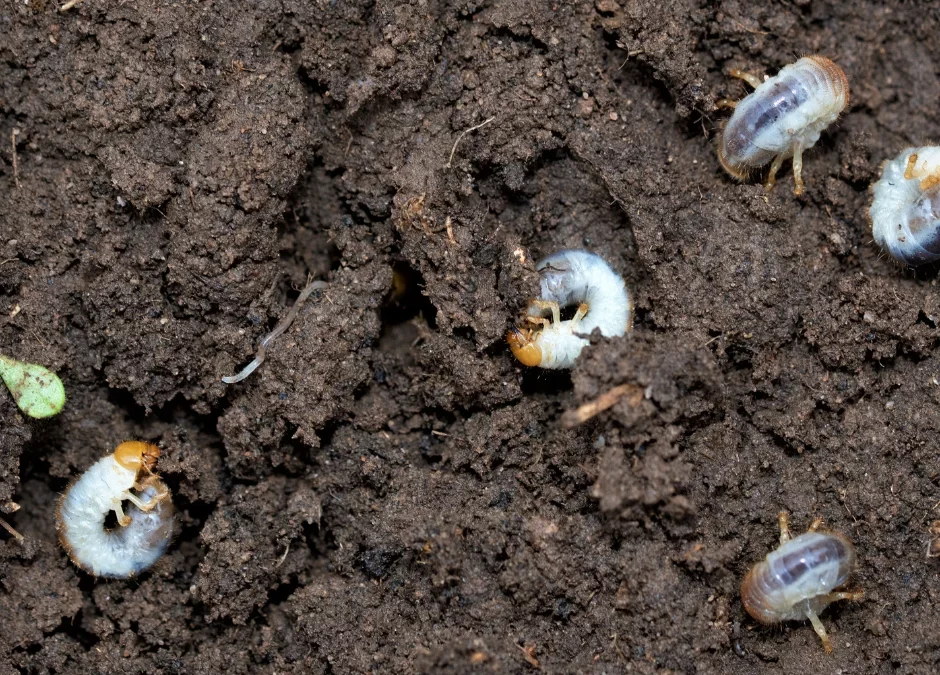Isn’t it annoying when you work so hard to make your garden a beautiful space but start finding grubs, spongy soil, and other problems on your lawn? We understand how frustrating this can be, especially if you don’t know what to do about these issues.
Fortunately, there are many homemade grub killer recipes and natural remedies to eliminate grubs on your lawn in Ontario.
Our lawn care experts understand your frustration and have created a complete guide on how to get rid of grubs in lawn naturally in Ontario.
What are Grubs?
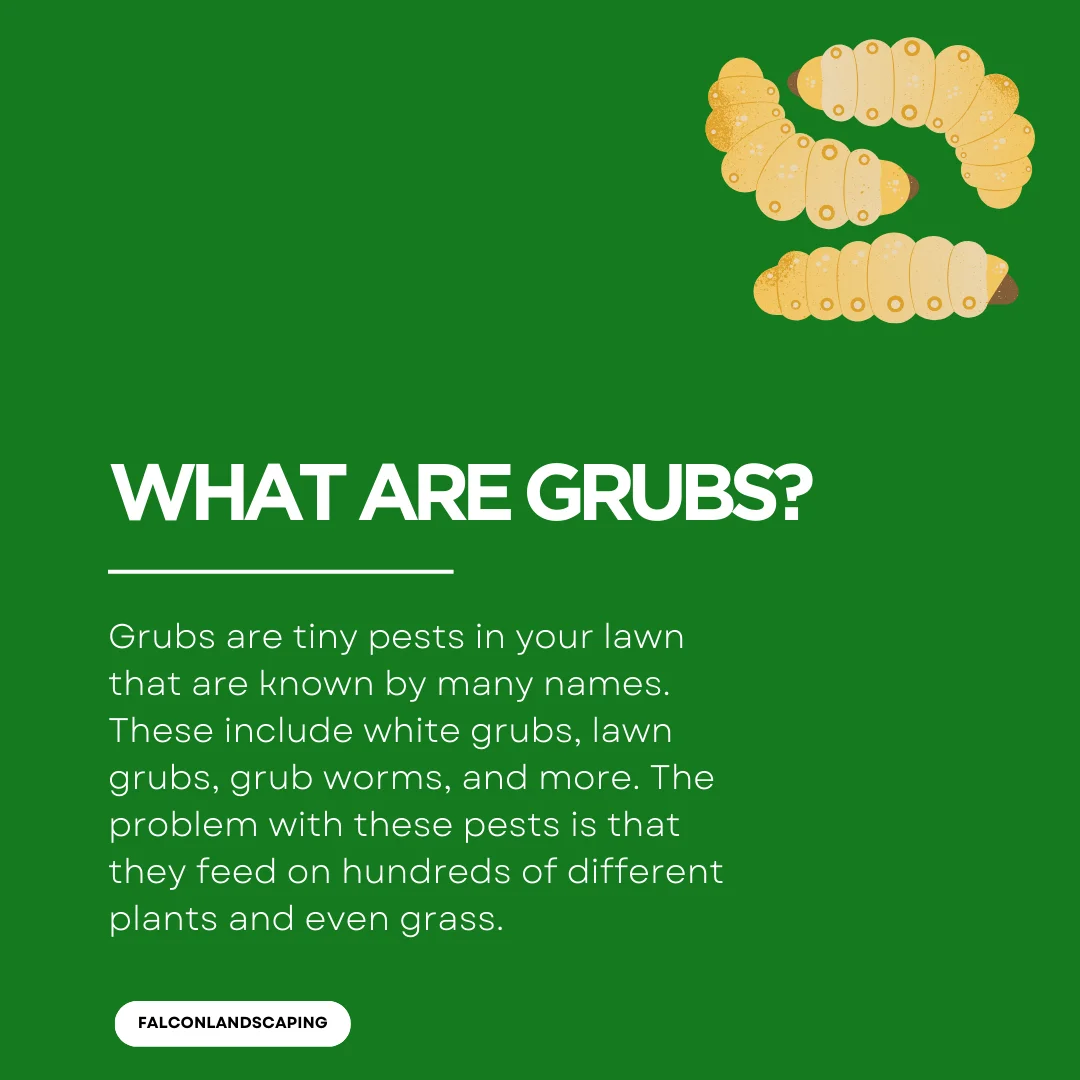
Grubs are tiny pests in your lawn that are known by many names. These include white grubs, lawn grubs, grub worms, and more.
These include the larval stage of various species that turn into grubs. The problem with these pests is that they feed on hundreds of different plants and even grass.
If you don’t take the right measures to control these pests in your lawn, they can wreak havoc in your garden.
What Causes Grubs in Lawn in Ontario?
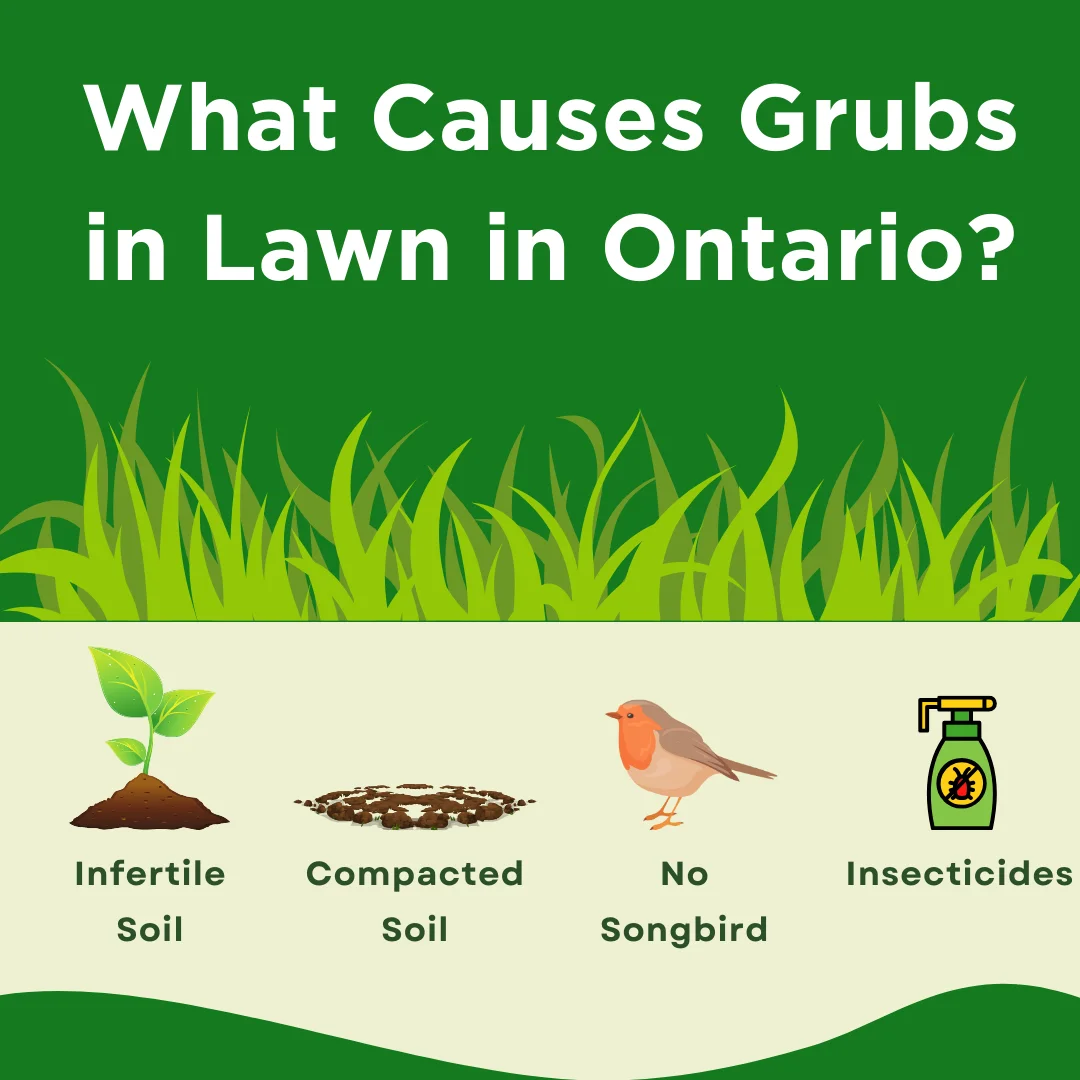
There can be a few reasons why grubs can develop on your lawn in Ontario. While these insects and pests are natural, your soil conditions can influence the population size of these grubs and the damage they cause.
Here are some causes of grubs in lawns:
- Infertile and thin soil: Grubs can occur inside these because of the lack of organic matter.
- Compacted soil: Grubs are likely to occur in such soil because grass roots can’t penetrate the soil more properly.
- Not being visited by songbirds: If songbirds do not visit your lawn, then it will have more insects and grubs.
- Using broad-spectrum insecticides: If you use too much insecticide, then it will kill both good and bad insects in your lawn, causing grubs.
These are some common reasons why grubs in lawns may occur. However, even taking precautions may still cause grubs on your lawn.
If that is the case, then you will have to learn how to get rid of grubs in lawn naturally for a grub-free lawn.
Lifecycle of Grubs in Ontario
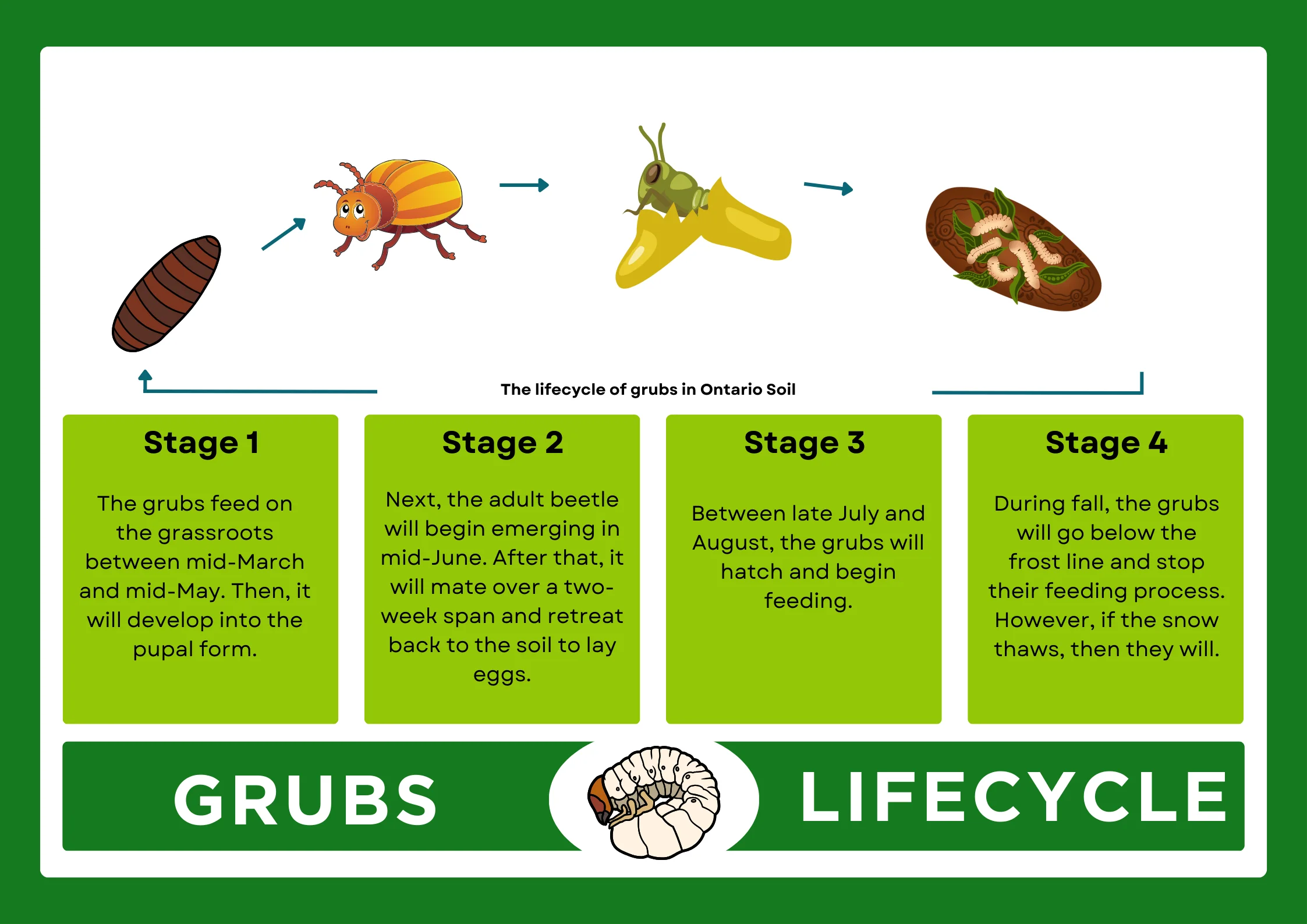
Understanding the lifecycle of grubs will help you determine in which phase they start to show signs, and you can get rid of them. Fortunately, their lifecycle is incredibly simple.
- Stage 1: The grubs feed on the grassroots between mid-March and mid-May. Then, it will develop into the pupal form.
- Stage 2: Next, the adult beetle will begin emerging in mid-June. After that, it will mate over a two-week span and retreat back to the soil to lay eggs.
- Stage 3: Between late July and August, the grubs will hatch and begin feeding.
- Stage 4: During fall, the grubs will go below the frost line and stop their feeding process. However, if the snow thaws, then they will.
- Stage 5: They will keep growing and feeding in the spring and grow incredibly large.
These are the five stages that the grubs will go through in your lawn. Such times are important to remember to add a natural grub killer to your lawn in Ontario at the right times.
Signs of Grubs in Lawn in Ontario
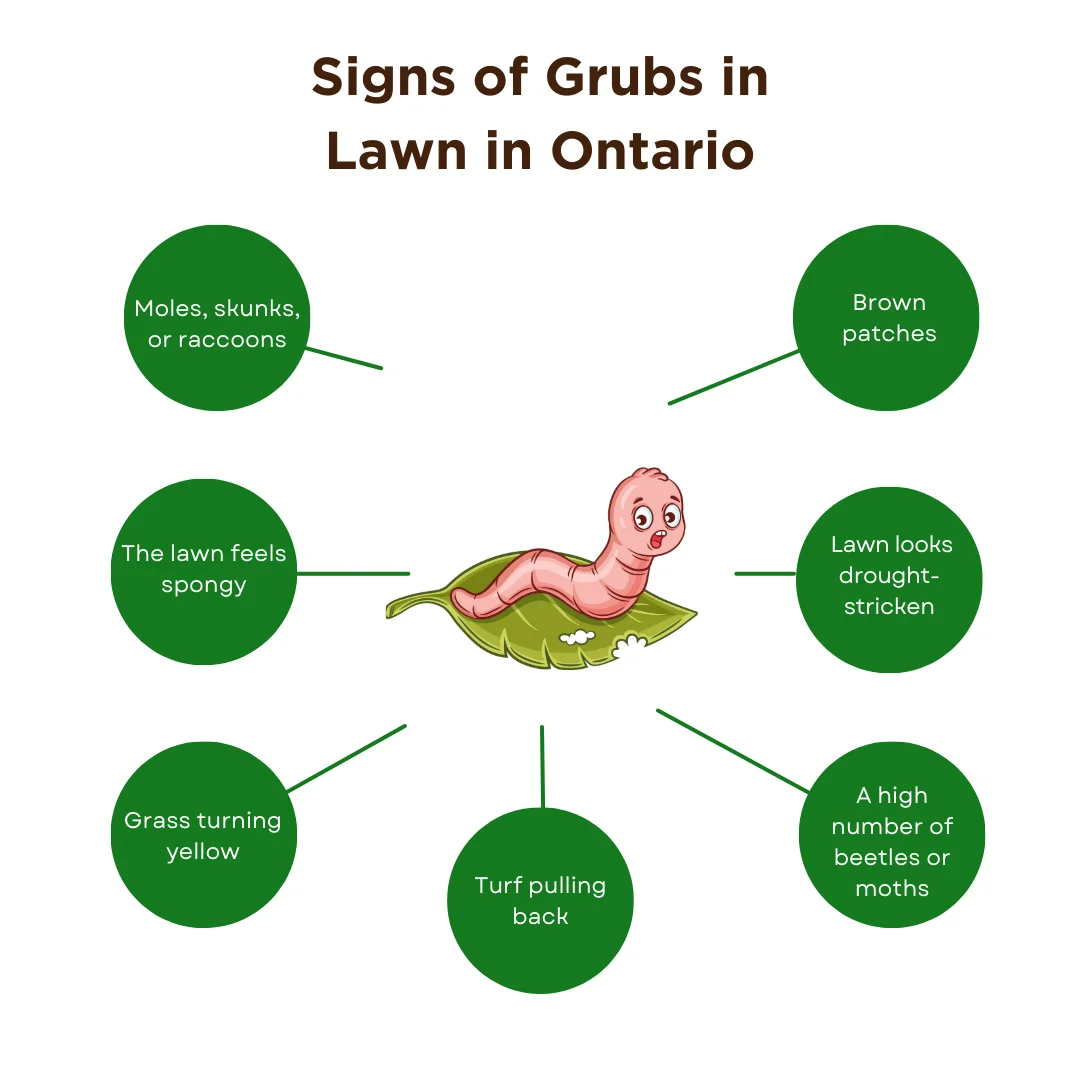
If you are worried about grubs in lawn in Ontario, it is crucial to understand the various signs that might indicate you have a grub infestation developing on your lawn.
Some of the most obvious signs of grubs in lawn include the following:
- Moles, skunks, or raccoons digging your yard
- The lawn feels spongy when you step foot on it
- You can easily pull back the turf or sod on your lawn like a loose carpet
- Grass turning yellow
- A high number of beetles or moths
- Your lawn looks drought-stricken
- Brown patches on your lawn
- Noticeable white grubs on your lawn
A good way to detect grubs in the lawn is to pull back grass or turf and then check the presence of grubs. During an infestation, there will be a significant number of grubs under every patch you pull.
Damage Caused by Grubs in Lawn in Ontario
The damage depends on the type of grubs in the lawn. For example, if you have June beetle adults in your lawn in Ontario, they will feed on aspen, poplar, oak, maple, elm, willow, and chestnut foliage.
Other than that, it will also strip away leaves from roses, shrubs, and many other plants. You will notice a lot of damage to your grass, plants, and greenery in your garden.
Another problem is that they are attracted to lights, which can be a nuisance for a lit garden at night. Adult Japanese beetles can also cause significant damage to your lawn, as they use more than three plant species as their hosts.
Do remember that all grub species will feed on the roots of various plants. They will also love feeding on the fibre-filled turfgrass on your lawn.
There will also be secondary damage on your lawn as raccoons and skinks will begin searching for these grubs to feed on them.
You will notice significant damage in the spring and fall when these grubs begin increasing in size fast and feeding close to the surface.
Common Types of Grubs in Ontario, Canada
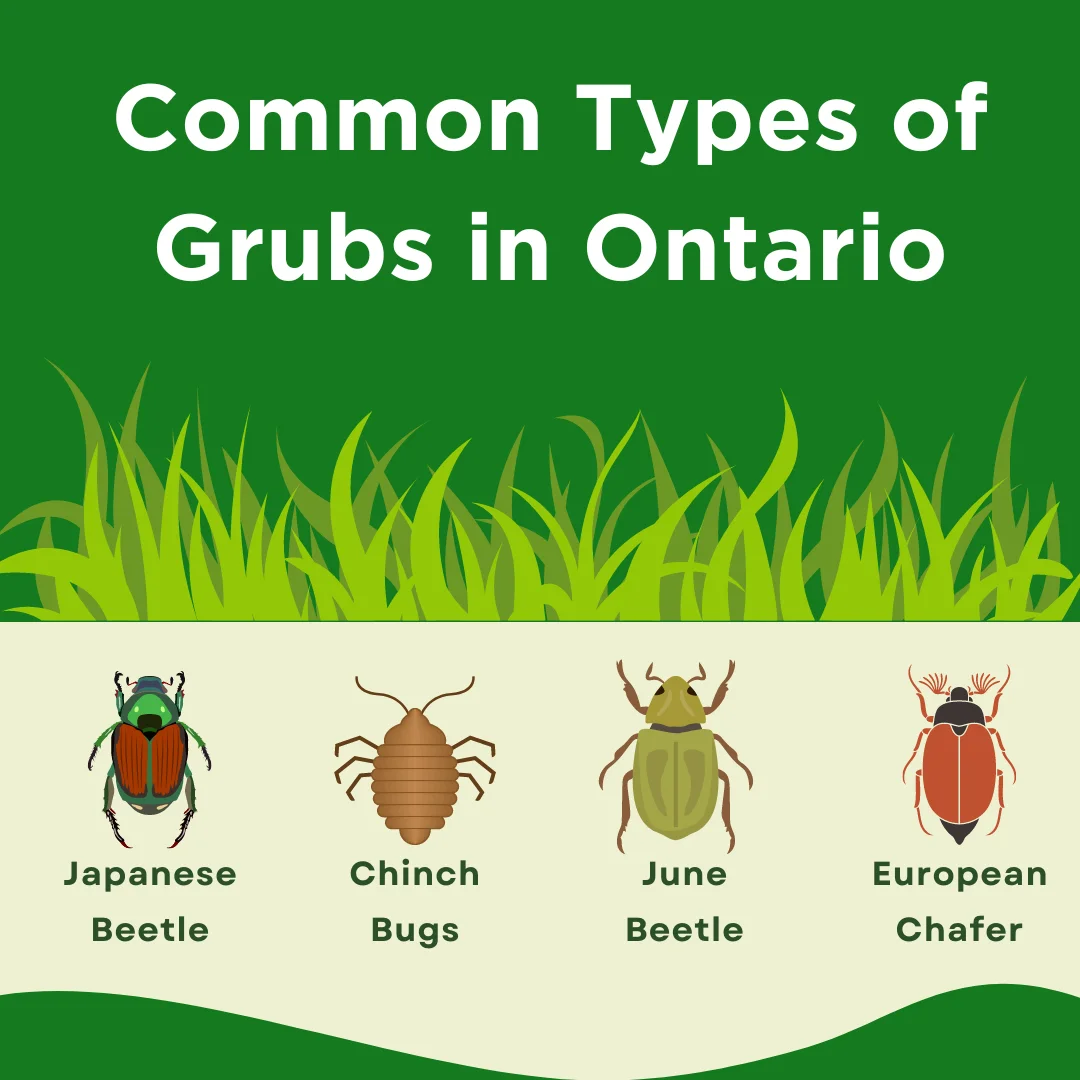
Before you begin searching for grubs in lawns, it is important to know what you are looking for. There are some common types of grubs you will find in Ontario.
These include the following:
1. Japanese Beetle
Japanese beetles are incredibly common in Ontario, and they can wreak havoc on your lawn if you don’t learn how to get rid of grubs naturally.
They show up in the early days of July and begin feeding on the shrubs and trees. Between a month and forty-five days, they will continue feeding.
After that, the female beetles will enter the soil and lay their eggs. These will hatch in the next two weeks and then also begin feeding on the soil.
The grubs will reach maturity late in the summer or early fall, and you will find them near the surface. During winters, they will go deeper into the soil and remain below to stay warm.
Be sure to keep an eye out on times other than winter to determine whether these beetles are on your lawn.
2. Chinch Bugs
Chinch bugs are not too common in Ontario, as you will mostly find them in Eastern Canada. However, it doesn’t hurt to look for these grubs in lawns in case they exist, as there have been infestations of these bugs before in Ontario.
These hairy bugs have mouthparts that pierce and suck on plants. For example, they feed on the sap inside the grass plants.
The bugs will appear on your lawn in mid-May, as they come up during this time after the winter. They also lay their eggs between May and June.
Then, these nymphs turn into a dark colour, usually black, and develop wings as they become more mature. Keep an eye out for these hairy pests on your lawn to determine which natural grub killer will work best to get rid of them.
3. June Beetle
June beetle is another common species of grubs in lawn in Ontario, and they emerge between May and early June. These beetles fly during dusk and feed and mate on broad-leaved shrubs and foliage.
During the daylight, they look for grass-filled areas and then go into the soil to lay eggs. These eggs take a few weeks to hatch, and these young beetles feed on plant roots and organic matter.
Fall is when these beetles burrow into the soil and stay there throughout the winter. As the soil warms in the spring, they return back and feed on the roots.
June beetles have a lifecycle of three years, and they cause the most damage during their second year. When this lifecycle ends, another one begins with a new generation of these beetles.
It is best to learn how to get rid of grubs in the lawn naturally before their second year to ensure the June beetles don’t break out on your lawn and wreak havoc.
4. European Chafer
European Chafers perhaps cause the least amount of damage to lawns. They emerge on the grass between mid-June and July and begin mating in large amounts during dusk.
The females lay eggs, and they take two weeks to hatch. By September, these new grubs will be mature and begin damaging your turf.
These grubs in lawns don’t get deterred by cold weather, as they dig deep in the soil and come back up during the springtime. So, it is crucial to be on the lookout for these grubs throughout the year and naturally get rid of them at the right time.
Best time to Treat your Lawn for Grubs
For all the grub species in Ontario, we recommend you apply the treatment after the larvae have hatched. This will happen between mid and late August or during the middle of September when your turf is moist.
So, late summer or early fall is the best time to apply a natural grub killer or treat your lawn naturally for grubs. Once you do, you won’t have an issue with these pests for long.
How to Get Rid of Grubs in Lawn Naturally in Ontario
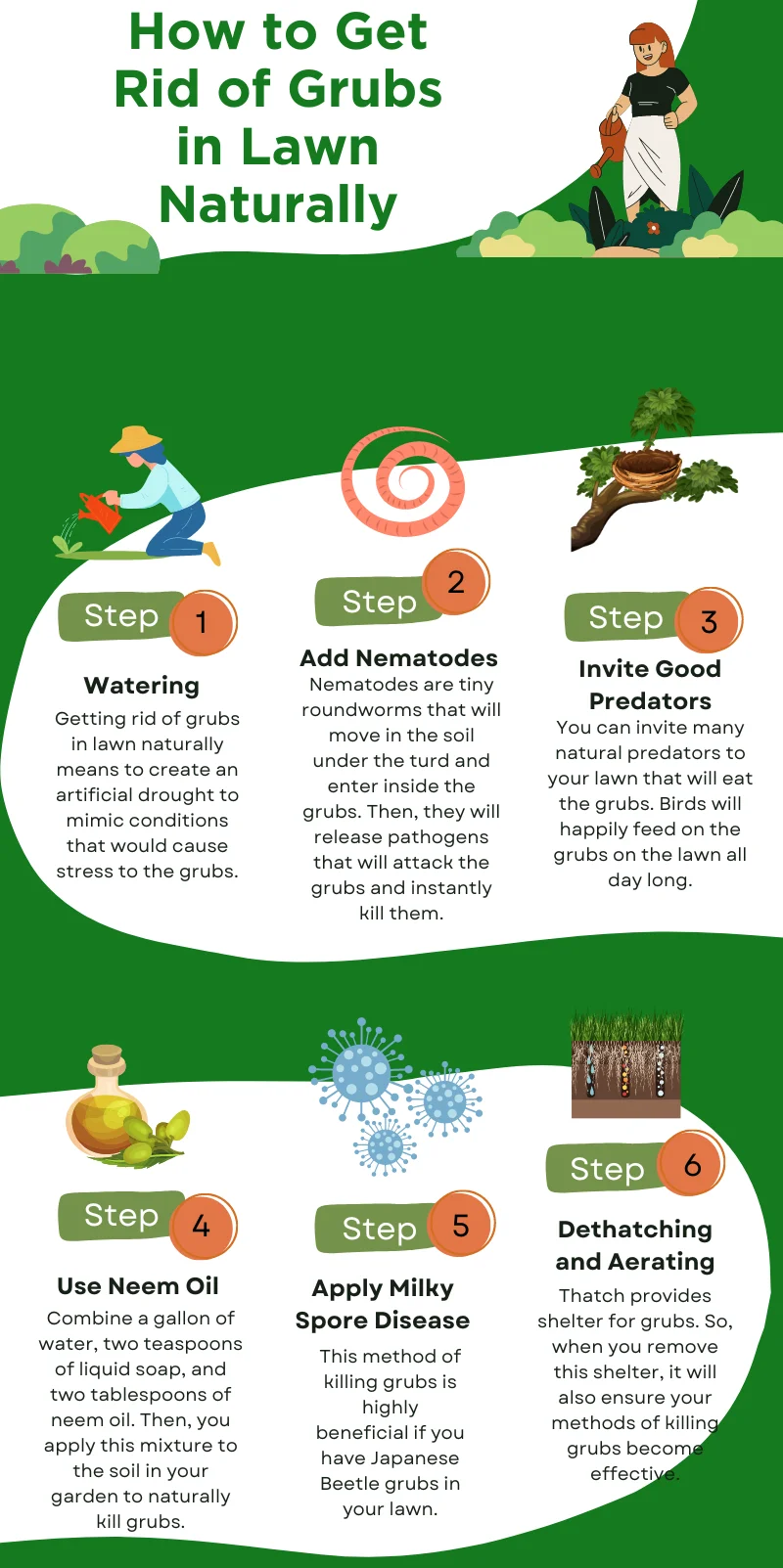
Now that you have all the important information, you might wonder how to get rid of grubs in lawns naturally in Ontario. The good thing is that there are various ways you can utilize to get rid of these grubs.
Some of these ways include the following:
1. Control the Amount of Watering on your Lawn
The first thing you must understand is that grubs thrive in moisture. High levels of moisture are exactly what they need to survive, which is why it is important to keep the watering to a minimum.
Getting rid of grubs in lawn naturally means to create an artificial drought to mimic conditions that would cause stress to the grubs. Keep in mind that doing this means your lawn may go dormant.
However, you can recover it completely once you begin the process of watering again. So, try to limit the watering till the grub population decreases.
2. Add Some Beneficial Nematodes to Your Lawn
Another important way how to get rid of grubs in lawns naturally is to add some beneficial nematodes to your lawn. These will get rid of the grubs in a matter of a few days.
Nematodes are tiny roundworms that will move in the soil under the turd and enter inside the grubs. Then, they will release pathogens that will attack the grubs and instantly kill them.
However, the key is to use nematodes that will work for the grubs you have on your lawn. Here are the steps you can follow to use this way properly:
- Choose the right nematodes that will work against the grubs on your lawn
- Mix these nematodes with distilled water in a sprayer
- Water your lawn to keep it moist
- Spray the nematodes on your lawn during the evening
We recommend you add nematodes in the evening because they are easily killed by heat and light. You can also ask the place where you buy the nematodes to let you know how to apply them correctly.
If you want the best results, you can repeat this after two weeks to ensure that all grubs in the lawn are killed.
3. Invite Good Predators that Will Eat the Grubs
You can invite many natural predators to your lawn that will eat the grubs. Remember, predators such as moles and raccoons will only damage the lawn.
However, other predators, such as birds, will happily feed on the grubs on the lawn all day long. On the other hand, chickens will also graze in your yard and pick up any grubs they see.
The easiest method we recommend how to get rid of grubs on the lawn naturally is to make your space attractive for birds to visit. You can add bird feeders, birdhouses, bird baths, and much more.
All of these attractions will ensure that more birds begin coming to your lawn and keep the population of the grubs in check.
4. Use Neem Oil for Grubs
Neem oil is a natural grub killer and repellant, as it will ensure that no more grubs come into your lawn. This is a natural home remedy popular among organic gardeners in the region.
All you have to do to use this grub killer is to combine a gallon of water, two teaspoons of liquid soap, and two tablespoons of neem oil.
Then, you apply this mixture to the soil in your garden to naturally kill grubs. The best part is that neem oil is easily available everywhere.
You can go to your nearest store to find this oil and create this remedy at home to get rid of these grubs.
5. Apply Milky Spore Disease to your Garden
One of the most effective grub killers is milky spore, and it is completely natural. This method of killing grubs is highly beneficial if you have Japanese Beetle grubs in your lawn in Ontario.
Another note to keep in mind is that it targets adult grubs and not larvae. Many people use this as a preventative method to kill grubs in two to three years of application.
Your local home garden store will have milky spores available for you to begin this process. For the best results, we recommend you apply milky spores a few times a year for two to three years.
After this, milky spores will control the grub population in your garden for the next two decades.
6. Opt for Dethatching and Aerating your Lawn
You might wonder how dethatching and aerating can help with getting rid of grubs naturally. Well, thatch is a thick layer of dead and living plant organic matter.
This layer provides shelter for grubs. So, when you remove this shelter, it will also ensure your methods of killing grubs become effective.
If you want to naturally get rid of your lawn from grubs, begin with dethatching and aerating, and then introduce other natural methods to kill your lawn.
7. Try to Relocate the Grubs
The method of relocation will not work for high populations of grubs. Instead, it will work best if you have a few grubs residing on your lawn.
We recommend you remove these grubs from the soil and relocate them further from your lawn. For example, if you have space and other animals in your yard, you can relocate these grubs to these animals.
They will happily feed on the grub, and it will solve your problem of these pests.
8. Make a Natural Grub Killer with Borax
Another great natural grub killer is a borax treatment. Borax is a common cleaning ingredient you can find in your house.
However, an important note to keep in mind is that high concentrations of this ingredient can kill your lawn. This is why it is crucial you be mindful of the amount of borax you use in your garden.
We recommend you fill a spray bottle with warm water and add a tablespoon of borax to the water. Then, apply this solution anywhere you find grubs on your Ontario lawn.
Don’t use this solution too frequently, and avoid using it on your vegetable gardens or flowerbeds, as these are sensitive to borax.
9. Replace the Lawn with Artificial Sod
If you are still wondering how to get rid of grubs in lawn naturally, then you can replace the lawn with artificial sod. It is a guaranteed way to get rid of grubs because there will be no natural environment for the grass to grow.
However, before you opt for this method, you must understand the costs associated with sod and the types of sod. These will provide you with some knowledge of what you can expect when you add artificial sod to your lawn.
Be sure to weigh the pros and cons of sod vs. grass before you add artificial turf to your lawn space.
10. Plant Grasses with Deep Roots
If you want to prevent grubs in lawns in Ontario, then you can plant grasses with deep roots in your lawn. You will not require any chemicals or pesticides for this method.
There are many grasses that will work well for this purpose in Ontario. Tall Fescue has a deep root system, doesn’t require a lot of watering, and is drought-tolerant.
What this means is that you will naturally eliminate conditions for grubs to thrive, as this grass will not require a lot of moisture. Many other varieties of grass can serve this purpose, so don’t forget to check your closest home garden store to select the right grass.
11. Create a Mixture of Water and Soap
You might think this is too simple, but it is also an effective grub killer. The soap itself is enough to kill any grubs that might roam on your lawn.
For this grub-killer recipe, we recommend you take a gallon of water and add three tablespoons of organic liquid soap. Then, spray this mixture on the soil or lawn to begin the process of naturally killing grubs.
12. Apply Diatomaceous Earth (DE) to your Lawn
Another great organic grub killer is DE. It is a pet-friendly way to get rid of grubs on the lawn, and it is safe to use throughout the house and any vegetable gardens.
This type of earth will dry out the insects and ensure they have been dehydrated to death. We recommend you use a small amount of this organic grub killer.
Just dust a little bit of DE around your plants and grass in the soil. Soon, the grubs will become dehydrated and die because of the harsh conditions.
FAQs
What homemade solution kills grubs?
Homemade solutions, such as borax, neem oil, and some soap and water, can easily get rid of grubs in lawns.
Will Epsom salt kill grubworms?
We don’t recommend using Epsom salt to kill grubs. Instead, neem oil is a better choice because it is safe to use. You can make your solution with some neem oil and water to kill grubs on your lawn.
Does dishwashing liquid kill lawn grubs?
Using dishwashing liquid is a classic home remedy to get rid of grubs. Applying some dish soap and water will kill any grubs quickly.
How do I bring grubs to the surface?
Mix a bucket of water and soap and pour it on the edge of where your grubs are located. After ten minutes, the grubs will begin showing up on the surface. The best time to do this is dusk or dawn, as these are the times when the grubs are most active on the lawn.
Final Thoughts
If you notice any grubs in lawn in Ontario, be sure to use any of these twelve ways to begin killing these pests. These organic methods will guarantee that you naturally get rid of the grubs without damaging your lawn.
On the other hand, if the grub problem on your lawn is out of control, then you can get in touch with our lawn care experts in Mississauga. We have the right tools and technology to eliminate any infestations regardless of how big your lawn is.

